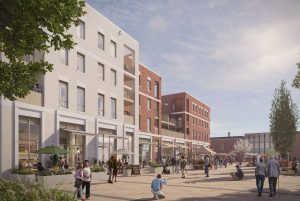High Street shop closures down to lowest rate for four years

HIGH Streets across the North West suffered the greatest net loss of stores of the UK regions, but closures reduced by 26% in the first half of 2015.
This is according to research compiled by PwC and The Local Data Company (LDC) for the half year to June 30.
It says 221 shops closed on the region’s high streets, a rate of nine stores a week.
This is the lowest closure rate in four years and also represents a 26% decrease in the number of retailers shutting up shop in the region compared to the same six months last year, when 297 closed, a rate of 11 a week.
The analysis of 5,118 outlets operated by multiple retailers in 29 town centres across the North West shows that 221 outlets closed in a six-month period compared to 156 openings, resulting in a net reduction of 65 stores on the region’s high street.
This sees the North West experience one of the highest net reductions in the number of stores, in line with the West Midlands and Greater London. However this is significantly less when compared to H1 2014 when there was a net reduction of 81 shops. Overall volumes of activity (openings and closures) have plummeted from 513 in H1 2014 to 377 in H1 2015. This reflects a less hostile environment for embattled retailers with fewer insolvencies and store portfolios streamlined in response to the advance of online shopping. Barbers, coffee shops, bars and restaurants were among those growing at the fastest rate during the first half of 2015 in the region, demonstrating how the North West high street is becoming more of a leisure destination than just pace for retail activity. The data also revealed that fashion shops were amongst the hardest hit in the region in the first half of 2015, followed by cheque cashing and banks.
PwC’s North West retail & consumer leader Neil McTiffin said: “This latest data shows that changes are continuing to take place across the region’s town centres, but the pace at which closure are happening is slowing. “The shifts in retailers’ store portfolios are a barometer for changes in society’s shopping habits. Closures in areas such as cheque cashing, women’s fashion and banks reflect the change in how consumers are spending and the increasing competition from online services. “In the region, traditional shops continue to be replaced by leisure (food, beverage and entertainment) and services have continued to decline especially in the area of travel agents and financial services. As leases come up for renewal and the diversity in town centre health becomes even clearer then further changes are expected for the foreseeable future.”
LDC director Matthew Hopkinson said: “The results of the openings and closures of chains in our top 500 town centres in the first half of this year are encouraging.
“Closure rates are down and the gap between openings and closures is levelling out. This is as a result of wider consumer confidence, adjustments to market rents and most importantly a better understanding by chain retailers as to the role and opportunity that shops still have to play in the ‘total retail’ environment. “As ever, the devil is in the detail. We are seeing the continuing decline of pubs and clothing shops whilst seeing previously expansive sectors such as banks, betting shops and cheque cashing all in retreat from the high street. “In the last five years alone over 62,000 shops of multiple retailers have opened and closed in the top 500 GB towns so look wider and that number rises significantly.”








